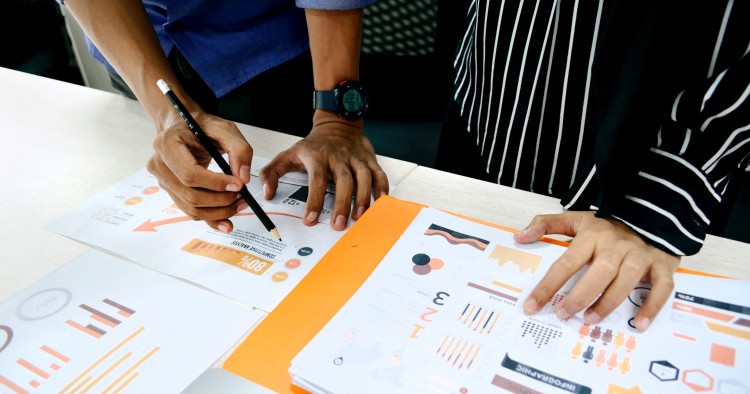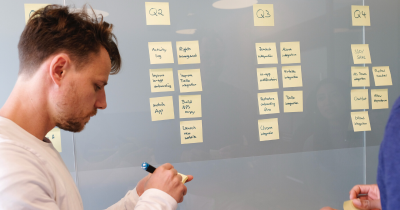The Unexpected Ways That Product Managers Can Benefit From UX Design

Strawberries and cream; gin and tonic; rhythm and blues.
These are all dynamic duos — one is made so much better by the other.
But product manager and user experience designer? For some reason, these two roles sometimes feel at odds with one another.
Often we hear that the relationship between PMs and UXDs can be a fraught one. There’s often a great deal of friction between them in organizations; their competing demands can lead to a tussle for control.
But actually, these two roles are two sides of the same coin. Both vying to champion the user. To create a product that people will not just find useful but love to use.
And what’s more: effective collaboration between product managers and user experience designers is absolutely crucial to bringing any new product to market.
So not only do we need to appreciate the similarities they share but to open our eyes to how the two can work in unison and bring even better products through development.
In this post, we’ll cover why product managers and UX designers should come together as a team and how you can start working more productively as a pair.
Let’s dive in…
A collaborative PM and UX duo is good for business — here’s why…
A PM's role is to plan, oversee and ultimately carry a successful product from initial ideation through to prototyping and lastly to launch.
They’ll hold the roadmap and work hard to coordinate the right stakeholders to drive a product to success, based on core strategic objectives.
But a PM’s function goes far beyond delivery.
It’s also their responsibility to understand the market; be an expert in customer needs, and ensure that each product or feature in the workstream will deliver strategic value for the business, and emotional value for the user.
And that sounds pretty similar to user experience, doesn’t it?
After all, a UX Designer’s mission should always be focused on problem-solving, and designing the most useable and enjoyable product to benefit the end-user.
In addition, as user experience affects every interaction and aspect of the product or feature being built, the UXD should be involved throughout the product life cycle, not simply brought in to assist in wire-framing and choosing the color of your app.
This shows us a significant overlap between PMs and UXDs — both want to design and build winning products with their target demographic’s needs in mind.
So then why would these roles end up in competition, either for creative vision or strategic control?
Well, this overlap in interests easily translates to an overlap of competencies. And team members with similar competencies often end up rising to the same challenges.
In fact, the Interaction Design Foundation goes so far as to suggest the roles of PM and UXD are so similar. They really ought to be performed by the same people.
And so therein lies the problem: chaos can ensue if an organization fails to define the expectations of each role or identify ways a PM and UXD can work in partnership rather than opposition.
How exactly? Either workload is doubled up, or important details get missed — both of which make for sluggish productivity. Muddied job specs cause stress and confusion — leaving team members demotivated and disengaged.
Ultimately: the product ends up suffering as a result.
But, get it right — and you should see an uplift in the quality and creative products and features your team can build.
Apple is a best-in-class example of product management and user experience functions working in tandem, creating market-leading products to bring in a huge profit, one year after another.
Design has always been Apple’s differentiation factor. And so harmonious and productive is the product development process that the company looks likely to become the world’s first $1 trillion business organization.
Apple's chief design officer, Sir Jony Ive, said it himself: “The best ideas start as conversations.”
So what can we take from this?
That collaborative, communicative cooperation between a product manager and a UX designer helps them speaking the same language. It allows them to bounce ideas off each other and practice divergent thinking. And, in turn, transfer this positive energy into greater — more profitable — value delivered to the end-user.
Don’t worry if the relationships between PMs and UXDs are less-than-ideal in your organization right now.
All can be resolved…
How product managers can collaborate more effectively with UX designers
Whilst there’s much to be gained from the collaboration between PMs and UXDs, it’s not always smooth sailing.
Here are five simple ways to begin building bridges between product managers and user experience designers…
Be empathetic
Empathy is at the core of product development.
Without empathy, you cannot understand — and design for — the unique problems and jobs that a user has to cope with.
Build a product without empathy, and it’s unlikely to gain much traction.
And so the same goes for the working relationship between PMs and UXDs. Taking the time to empathize with one another can be transformational for your creative partnership.
Next time you’re faced with a clash of interests, motivations, or vision — take a second to step back and see things from their perspective. Why is what they are doing so important to them? What could you be doing to make their job easier? How would you feel if you were in their position?
Acknowledge your differences, as well as your similarities. Because, as experience design leader, Sarah Deane, says:
“It is in understanding the different job roles, their intersections, values, and accountabilities that you will end up with a great product.”
Empathy is second nature to product visionaries, so exercise it.
Share knowledge
Yes, there’s a crossover between product management and user experience design roles.
But there are also crucial differences too. And within these differences comes the opportunity to learn from each other and develop skills as a result of productive collaboration.
Being aware of each other’s strengths — and weaknesses — can help overcome any confusion surrounding who is best to take on certain responsibilities between PM and UXD.
And, if you ask us, there are certain product development activities, like a scrum meeting, where a UX designer should absolutely be invited in.
This is not just good for the project as a whole but also in furthering a PM’s skill set. Product managers become more familiar with UX as a mindset by working in collaboration with a user experience designer. And a fluency with UX theories and terminology bolsters a product manager’s skill set in a number of ways.
For one: product managers are measured by the success of their product. Utilizing user experience research tools at the early design development stage equips PMs with the knowledge to select only the most valuable features and products to take through to build.
Two: it opens up a feedback loop with UXDs using language they understand, helping to iteratively improve products and features as the design progresses.
And three: learning how to express the emotional elements of design from a UX counterpart helps a PM convey this importance to stakeholders. In an increasingly competitive marketplace, a product’s experience can be a make or break for its success — a PM who knows and respects this can garner further investment into user experience design for their products.
All of which amounts to better products being built.
Clearly define the strategy
Every designer and product manager knows the importance of a good brief.
And to reduce friction between management and design, the PM should brief UXDs thoroughly and often.
A good design brief should cover:
Who is the target user?
What is the working budget? And is this set?
Are there strict timings to adhere to?
Is there scope to change direction or shift the development once in progress?
But a great brief? A great brief also explains the strategic reasoning behind a build. PMs should help UXDs see the bigger picture — how this feature or product helps push the organization’s agenda.
Why?
Because this will increase their motivation, encourage their full involvement, and — after time — give them the know-how required to start making their own strategic decisions about which builds should be prioritized and which should be left behind.
Encourage feedback
Two-way feedback between PM and UXD should be the cornerstone of collaboration.
Sense-checking the strategic value of a product or feature helps ensure the best possible outcome. And a user experience designer has to feel able to question a PM's decisions, if they want to.
Remember: both the product manager and user experience designer will be seeing the project from different viewpoints, with slightly varying motivations. Use these differences as an advantage. Encourage feedback from both parties to uncover new opportunities and troubleshoot unexpected issues.
Be open to the challenge
Product management is a mindset and less of a job title.
And PMs have control over how they choose to lead their design team.
Some choose to micro-manage or power trip: resulting in an entitled sense of control over the product.
Others exhibit the right core competencies and EQ and thrive in the role of product lead.
In the same vein: PMs can also choose to be open to UX involvement in the design development process.
Or not.
But, for all the reasons we’ve discussed through this post, we’d highly recommend they do.

Malte Scholz

Read also

Experience the new way of doing product management

Experience the new way of doing product management







